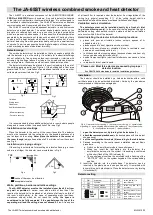
TESTING EXTERNAL CLOCK:
Flip the CLOCK SWITCH into the “UP” position. Using an external
clock source, the Sequence 8 can go a bit into audio range
(somewhere above 1kHz). Test this by plugging in an external clock
source or square wave from an LFO and run it into the CLK IN jack on
the Sequence 8.
Monitor the CLK OUT and turn the LFO /Oscillator / Clock Generator
up as high as you can and you should hear an audio pitch. Now
monitor one of the CV Outputs and make sure its Attenuator is set fully
clockwise. Set some step knobs up the right way and you get some
crude wave shaping sounds! Now
flip the CLOCK SWITCH into the
“DOWN” position.
TESTING RANDOM:
While the Sequence 8 is running on its internal clock, flip the
RANDOM switch into the “UP” position. Slowly rotate the RNDRATE
(Random Rate) knob clockwise until you will notice the (via the LEDs
on the front panel) the sequence start to move around randomly. This
random behavior acts subtly at lower settings and will great faster as
the knob is rotated clockwise. NOTE: This does not effect the CLOCK
OUT. Now flip the RANDOM switch to the “DOWN” position.
TESTING RESET:
While the Sequence 8 is running on its internal clock, press the red
RESET switch and you should notice the sequence resetting back to
Step 1
Now plug in a cable into the RESET output and plug the other end into
Step 2’s Reset input. The sequence should be holding on Step 1.
When you plug into Step 3’s Reset input, it should be holding on Step
2. Step 4’s Reset input should
hold on Step 3. Step 5’s Reset input
should
hold on Step 4. Step 6’s Reset input should
hold on Step 5.
Step 7’s input should hold on Step 6. Step 8’s Reset input should hold
on Step 7.






















